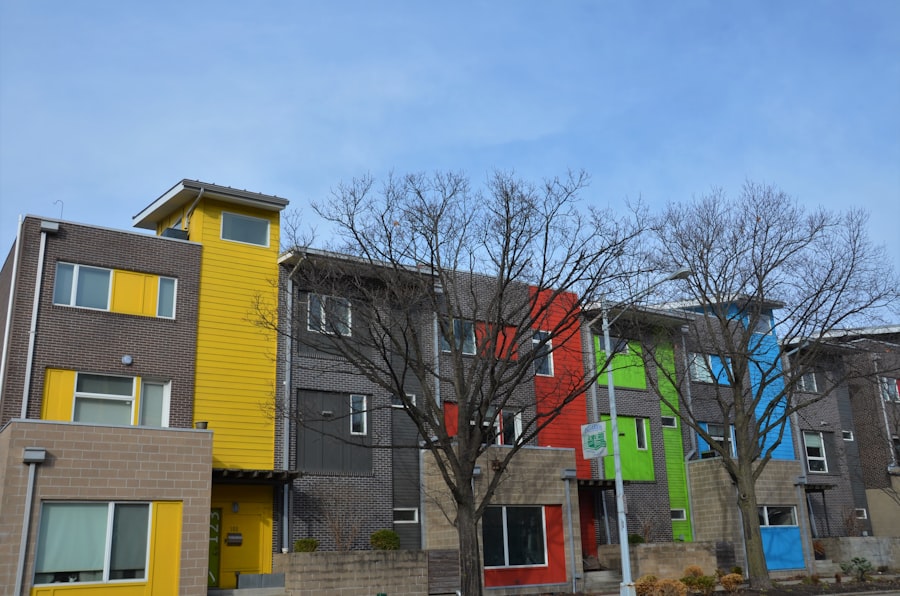As you delve into the realm of European housing policies, you will discover a complex tapestry woven from diverse cultural, economic, and political threads. These policies are not merely bureaucratic frameworks; they reflect the values and priorities of societies across the continent. From the bustling streets of Paris to the serene neighborhoods of Scandinavia, housing policies shape the living conditions of millions.
Understanding these policies is crucial for grasping how different nations address issues such as affordability, sustainability, and social equity. In recent years, the urgency surrounding housing has intensified, driven by factors such as urbanization, demographic shifts, and economic disparities. As you explore this landscape, you will encounter a variety of approaches tailored to meet the unique needs of each country.
The interplay between government intervention and market forces creates a dynamic environment where solutions are continually evolving. By examining the historical context and current initiatives, you will gain insight into the challenges and opportunities that lie ahead in European housing.
Key Takeaways
- European housing policies have evolved over time to address various social, economic, and environmental challenges.
- Historical background of European housing policies reveals the influence of different political, economic, and social factors on housing development.
- Western European countries have implemented diverse housing policies to ensure affordable and sustainable housing for their citizens.
- Eastern European countries have also developed housing policies to address the unique challenges and opportunities in their respective regions.
- Affordable housing initiatives, social housing programs, and policies for vulnerable populations are key components of European housing policies aimed at addressing housing inequality and social exclusion.
Historical Background of European Housing Policies
To fully appreciate the current state of housing policies in Europe, it is essential to consider their historical evolution. The aftermath of World War II marked a significant turning point, as many countries faced a dire need for reconstruction and housing provision. Governments took on a more active role in addressing housing shortages, leading to the establishment of public housing programs.
You will find that this period laid the groundwork for many contemporary policies, as nations sought to provide affordable and adequate housing for their citizens. As you trace the development of these policies through the decades, you will notice how economic fluctuations and social movements have influenced their trajectory. The 1970s oil crisis, for instance, prompted many governments to reassess their housing strategies in light of rising costs and inflation.
The subsequent shift towards neoliberal policies in the 1980s and 1990s introduced market-oriented reforms that prioritized privatization and deregulation. This historical context is vital for understanding the current debates surrounding housing affordability and accessibility across Europe.
Housing Policies in Western European Countries

In Western Europe, housing policies often reflect a commitment to social welfare and inclusivity. Countries like Germany, France, and the Netherlands have developed robust frameworks aimed at ensuring that citizens have access to quality housing.
For instance, Germany’s Mietpreisbremse (rent control) aims to curb excessive rent increases in urban areas, demonstrating a proactive approach to maintaining affordability. Moreover, Western European countries have increasingly recognized the importance of sustainable development in their housing policies. As you explore initiatives in cities like Amsterdam and Copenhagen, you will see how urban planning integrates green spaces and energy-efficient designs into residential projects.
These efforts not only enhance the quality of life for residents but also contribute to broader environmental goals. The commitment to sustainability is evident in various programs that promote eco-friendly building practices and renewable energy sources.
Housing Policies in Eastern European Countries
| Country | Housing Policy | Homeownership Rate | Affordable Housing Units |
|---|---|---|---|
| Poland | Public housing programs | 72% | 500,000 |
| Hungary | Rental subsidies | 67% | 300,000 |
| Czech Republic | Mortgage interest deduction | 75% | 400,000 |
In contrast to their Western counterparts, Eastern European countries face unique challenges in their housing policies, shaped by a history of state socialism and recent transitions to market economies. As you examine nations like Poland, Hungary, and Romania, you will notice that many are still grappling with the legacies of their past. The privatization of state-owned housing stock has led to significant disparities in access and affordability, often leaving vulnerable populations at risk.
Despite these challenges, Eastern European countries are beginning to implement innovative housing policies aimed at addressing pressing needs. You may find that initiatives focused on social housing are gaining traction as governments seek to provide support for low-income families and marginalized groups. Additionally, urban renewal projects are emerging in major cities, aiming to revitalize neglected neighborhoods while fostering community engagement.
These developments reflect a growing recognition of the importance of inclusive housing strategies in promoting social cohesion.
Affordable Housing Initiatives in Europe
Affordable housing remains a critical issue across Europe, with many cities experiencing rising rents and increasing demand for accessible living options. As you explore various initiatives aimed at tackling this challenge, you will encounter a range of strategies employed by different countries. For instance, some nations have introduced inclusionary zoning policies that require developers to allocate a percentage of new units for affordable housing.
This approach not only increases the supply of affordable options but also promotes socio-economic diversity within communities. In addition to regulatory measures, innovative financing models are emerging as viable solutions to enhance affordability. You may come across examples of public-private partnerships that leverage both government resources and private investment to create affordable housing projects.
These collaborations can lead to more efficient use of land and resources while ensuring that low-income families have access to safe and stable homes. As you analyze these initiatives, it becomes clear that addressing affordability requires a multifaceted approach that considers local contexts and community needs.
Social Housing Programs in Europe

Social housing programs play a pivotal role in addressing housing insecurity across Europe, particularly for low-income individuals and families. As you investigate these programs, you will find that they vary significantly from one country to another, reflecting different political ideologies and economic conditions. In countries like Sweden and Austria, social housing is often viewed as a fundamental right, with governments investing heavily in the construction and maintenance of affordable units.
You will also discover that social housing programs are increasingly incorporating elements of community development and support services. For example, some initiatives focus on providing not just shelter but also access to education, healthcare, and employment opportunities for residents. This holistic approach recognizes that stable housing is just one component of overall well-being and seeks to empower individuals to thrive within their communities.
As you explore these programs further, you will see how they contribute to social cohesion and reduce inequalities within society.
Housing Policies for Vulnerable Populations in Europe
The need for targeted housing policies for vulnerable populations is more pressing than ever in Europe. As you examine the various strategies employed by different countries, you will encounter initiatives designed specifically for groups such as refugees, the elderly, and individuals experiencing homelessness. For instance, many nations have implemented rapid rehousing programs aimed at swiftly transitioning homeless individuals into permanent housing while providing necessary support services.
You may also find that some countries are adopting inclusive approaches that prioritize accessibility for people with disabilities or those facing discrimination based on ethnicity or gender. By recognizing the unique challenges faced by these populations, governments can develop tailored solutions that promote equity in housing access. As you explore these policies further, it becomes evident that addressing the needs of vulnerable groups is not only a moral imperative but also essential for fostering inclusive societies.
Urban Planning and Development in European Housing Policies
Urban planning plays a crucial role in shaping housing policies across Europe, influencing everything from land use to transportation infrastructure. As you delve into this aspect of housing policy, you will discover how cities are increasingly adopting integrated approaches that prioritize sustainable development and community engagement. For example, many urban planners are now focusing on creating mixed-use developments that combine residential units with commercial spaces and public amenities.
You will also encounter innovative strategies aimed at enhancing livability within urban environments. Concepts such as “15-minute cities,” where residents can access essential services within a short walk or bike ride from their homes, are gaining traction in cities like Paris and Barcelona. This approach not only reduces reliance on cars but also fosters stronger community connections by encouraging local interactions.
As you explore these urban planning initiatives further, you will see how they contribute to creating vibrant and resilient communities.
Sustainability and Green Housing Initiatives in Europe
Sustainability has become a cornerstone of housing policy discussions across Europe as governments grapple with climate change and environmental degradation. As you investigate various green housing initiatives, you will find that many countries are prioritizing energy efficiency and sustainable building practices in their residential projects. For instance, Germany’s Passivhaus standard emphasizes ultra-low energy consumption in new buildings, showcasing how innovative design can significantly reduce carbon footprints.
You may also discover that sustainability extends beyond individual buildings to encompass entire neighborhoods and communities. Many cities are implementing green infrastructure projects that integrate parks, green roofs, and renewable energy sources into urban landscapes. These initiatives not only enhance environmental resilience but also improve residents’ quality of life by providing access to nature and reducing urban heat islands.
As you explore these sustainability efforts further, it becomes clear that they represent a vital response to the pressing challenges posed by climate change.
Comparing Homeownership and Rental Policies in Europe
The balance between homeownership and rental markets is a defining feature of European housing policies. As you analyze different countries’ approaches to these two sectors, you will find significant variations influenced by cultural attitudes towards property ownership and government intervention. In countries like Spain and Italy, homeownership is often seen as a key component of social status and stability, leading to policies that encourage purchasing over renting.
Conversely, nations such as Switzerland and Germany have developed robust rental markets characterized by long-term leases and tenant protections. You may find that these countries prioritize rental stability as a means of promoting social equity while ensuring access to quality housing for all residents. By comparing these differing approaches, you will gain insight into how cultural values shape housing policies and influence individuals’ choices regarding homeownership versus renting.
Future Trends and Challenges in European Housing Policies
As you look ahead to the future of European housing policies, several trends and challenges emerge on the horizon. The ongoing impact of globalization and migration continues to reshape urban landscapes across Europe, necessitating adaptive policy responses that address diverse needs while fostering social cohesion. Additionally, the rise of remote work has prompted discussions about reimagining urban spaces and redefining what constitutes “home” in an increasingly flexible world.
However, significant challenges remain as well—affordability continues to be a pressing issue in many cities, exacerbated by rising construction costs and stagnant wages. Furthermore, climate change poses an urgent threat that demands innovative solutions within housing policy frameworks. As you navigate these complexities, it becomes evident that collaboration among governments, communities, and private stakeholders will be essential for developing effective strategies that promote sustainable and inclusive housing solutions for all Europeans.
In conclusion, your exploration of European housing policies reveals a rich landscape marked by historical legacies, diverse approaches, and evolving challenges. By understanding these dynamics, you can appreciate the critical role that effective housing policies play in shaping societies across the continent—ensuring that everyone has access to safe, affordable homes while fostering vibrant communities for generations to come.
In exploring the nuances of European housing policy, a comparative analysis can provide valuable insights into the effectiveness of different approaches across the continent. For a deeper understanding of how various countries tackle housing challenges, you can refer to the article on wealth growth strategies, which discusses economic factors influencing housing markets.
